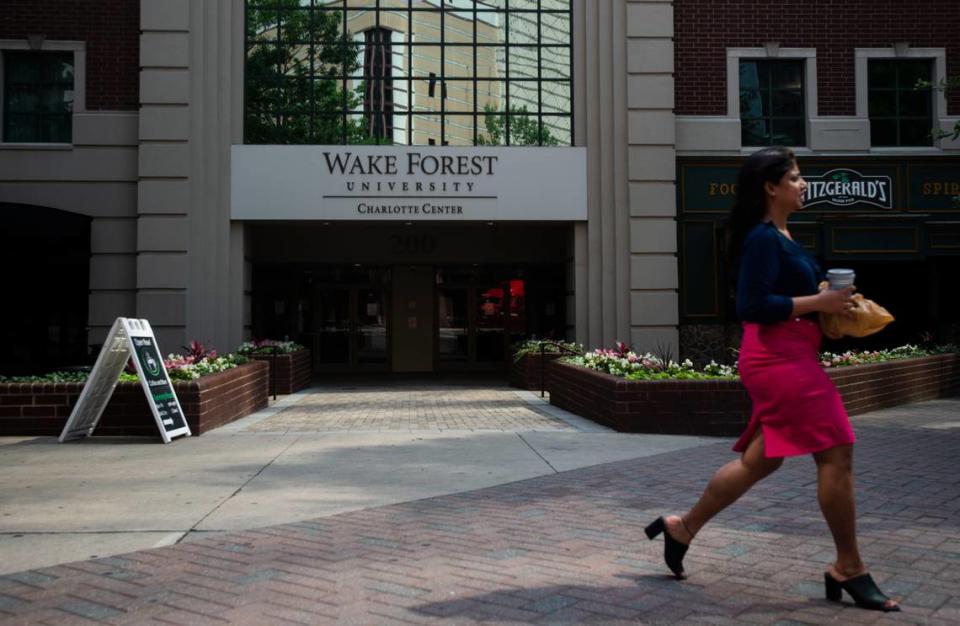1 out of 5 uptown office floors sit vacant now. What that means for Charlotte
Charlotte has rarely, if ever, seen as much office space sitting empty in uptown as it has now.
If you took all the empty office floor space spread out across uptown and put it in one building, it would fill the entire Bank of America headquarters — the state’s tallest skyscraper — three times over.
Put another way, roughly one in every five office floors in uptown sits empty, setting a record late last year not seen in at least the last 25 years, according to real estate services firm JLL.
What’s more, the 185 empty floors — out of about 940 tracked — is also more than what the city likely has ever seen before, partly because it’s been been growing for so many years, said Barry Fabyan, senior managing partner with JLL.
The vacancies play a role in roughly a dozen office properties across Charlotte that are confronting troubled mortgage loans, according to data and analysis from CoStar Group and real estate firm Trepp. The buildings range from mid-rise suburban campuses to uptown towers.
For some building owners, it could have been a case of bad luck: entering into a loan a few years before the pandemic hit only to see tenants give up leases during one of the most dramatic shifts to the modern office environment.
The vacancy and distressed loan numbers are a stark illustration of where the Charlotte office market has found itself, as building owners contemplate a future where fewer workers show up to the cubicle today than were there prior to the pandemic.
An uptown Wells Fargo tower complex goes up for sale. Lots of options for what comes next
Of roughly 23 million square feet of office space in uptown, about 5 million — close to 22% — sits vacant, Fabyan said. About 90 of the 185 empty floors are contained in just five buildings, he noted. He considers a healthy office market to have between 75 and 100 empty floors.
“Office buildings are the weak link in commercial real estate right now,” said Mark Vitner, chief economist at Charlotte-based Piedmont Crescent Capital, “and the weakest link in the office sector is the oldest building in the central business districts.”
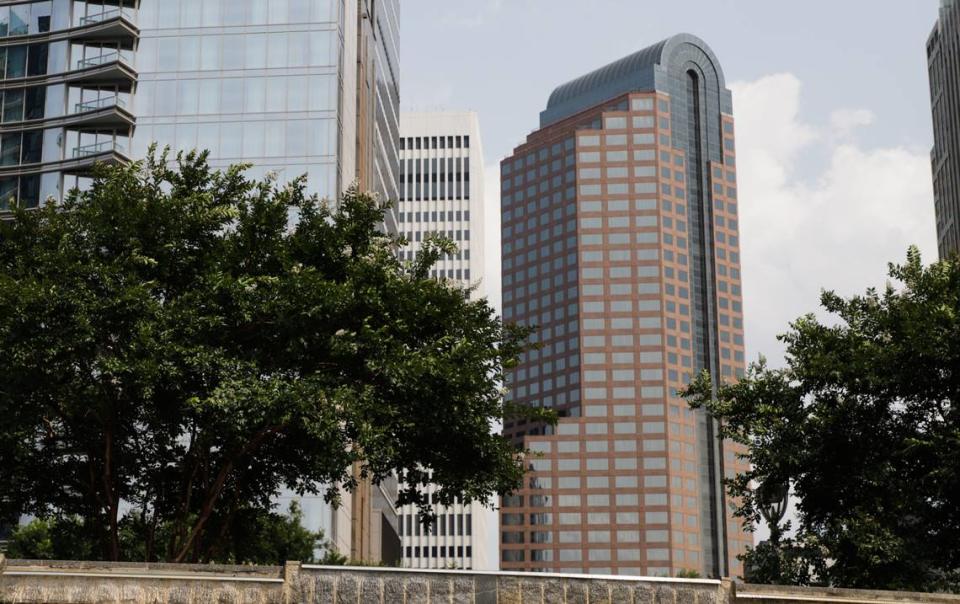
Problems and opportunities in uptown real estate market
With less buyer demand, commercial real estate experts say building values could go down.
That presents an opportunity for a new owner to come along. Some office buildings could be retrofitted into other uses, like apartments or hotels, experts say.
One local group, Charlotte Center City Partners, is studying what other cities are doing with older buildings to see how they can become repurposed.
There are ripple effects for the rest of the city, too, Fabyan and other commercial real estate experts told The Charlotte Observer. Retail can begin to suffer, with fewer people frequenting lunch spots or bars after work.
“If you want to have a city in decline,” Fabyan said, “just have a central business district in decline.”
The snowball effect, as Fabyan described it, can slowly erode the health of a city.
Uptown’s vibrancy is key to get people back. One sign of life: new owners of three decades-old office towers are injecting millions of dollars into building upgrades with the hope of luring workers back. Other signs include the number of visits to uptown crawling back up as is parking revenue, the Observer has reported.
New owners of old office towers in Charlotte make $42 million bet on getting workers back
Vitner, of Piedmont, has seen the activity first-hand while grabbing lunch the past week in uptown, with more crowds around.
He is confident the majority of people who were going into the office pre-pandemic will be back once the economy stabilizes. Vitner points to how much of the problem in the office market is largely confined to older buildings.
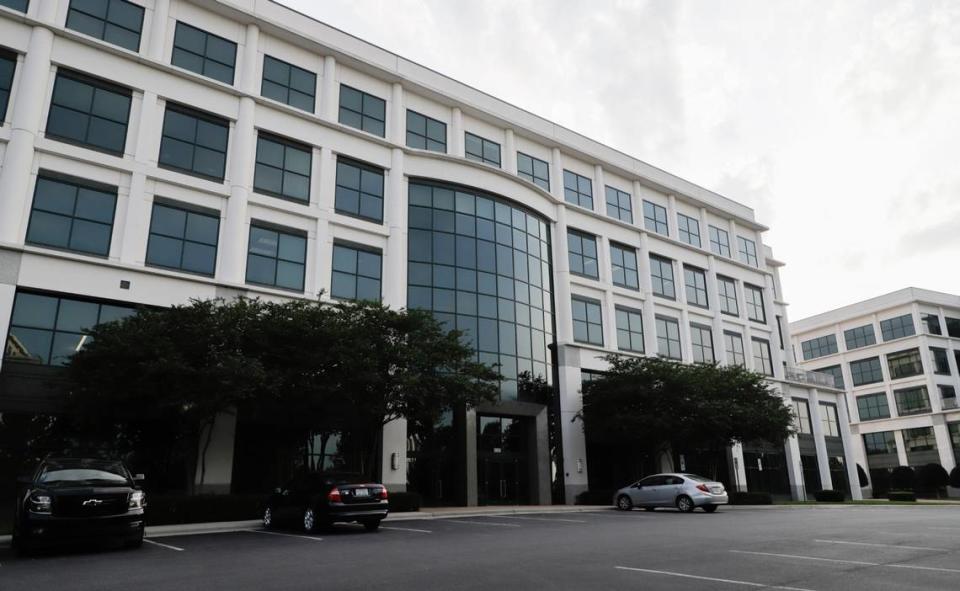
What’s driving all the Charlotte office vacancies
Vitner’s assessment is backed up by data.
Look at office towers built prior to 1990, and you’ll see availability rates that are at 33%, according to data from real estate research firm CoStar Group.
The same data point for offices built after 1990? It’s 11%. Availability rates reflect total vacant space plus the amount of space that’s coming available soon due to a tenant leaving as well areas being marketed as available for sublet.
Five of Charlotte’s biggest employers — Wells Fargo, Duke Energy, Bank of America, Truist and Ally — historically have helped absorb gluts in empty office space, Fabyan said. But each company has made big moves to consolidate space or relocate to newer office buildings.
Earlier this year, Wells Fargo announced it was moving employees out of One and Two Wells Fargo Center buildings. Duke Energy recently shrunk its real estate footprint in uptown after selling two decades-old properties. The company is moving into its new 40-story uptown high-rise.
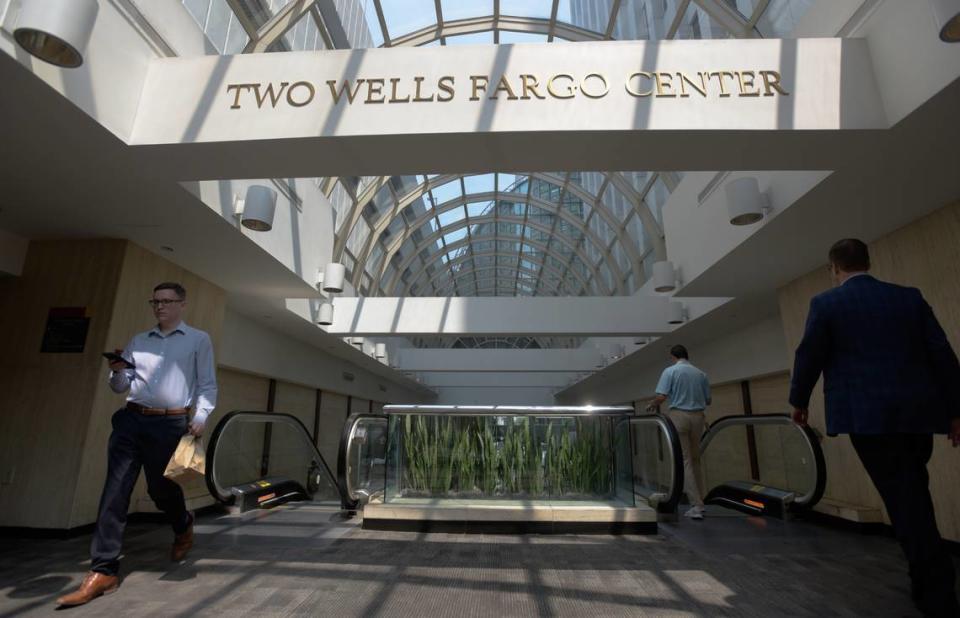
Uptown is relying more on smaller moves by office tenants that take up a floor or two of space. These are positive signs but don’t put a dent in the vacancy problem, Fabyan said.
Compounding those factors: companies have shifted to allowing more hybrid and remote work.
Plus, tenants are following a “flight to quality,” experts say, where they seek out modern buildings with more amenities. Look no further than the southern edge of uptown, where some companies have recently relocated to Legacy Union, a multi-building development near Bank of America Stadium.
And companies like Grant Thornton, the tax, audit and advisory firm, recently have made moves from uptown to South End.
After COVID sent workers home, companies began shrinking their real estate footprint, said John Culbertson, managing partner at Charlotte-based Cardinal Real Estate Partners.
To entice workers back, companies looked at areas that had more appeal for younger employees, he said. It’s a tough sell for companies to bring employees back to dated office buildings.
“Millennials are like, ‘Hey, if you bring us back, we will be in South End where we want to walk to breweries,’ ” Culbertson said.
See our map of Charlotte office properties facing mortgage loan trouble
Investments in uptown
But some uptown office building owners are not giving up on the neighborhood. In fact, they’re investing more.
In 2018, Pennsylvania-based Somerset Properties purchased the 15-story Trade West building for $24 million, Mecklenburg County property records show. Built in 1957, Trade West sits at the corner of West Trade and South Church streets.
Somerset pumped $8.5 million into a new facade, entrance lobby, elevators, lounges and meeting spaces, managing principal Mark White said. They’ve also upgraded the ground-floor restaurant, King’s Kitchen.
The investment appears to be paying off. In the last year, brokers for the building counted 28,000 square feet of new and resigned leases, according to White.
Asked about tenants who might want to be in South End, White said his view of that neighborhood is that it complements uptown. “The success of those two submarkets is not mutually exclusive,” White said.
First look at latest towers coming to South End, planned for near Common Market
In his experience, White finds both companies and employees are pushing to get back in the office to collaborate.
But as work from home trends are likely to stay in some form, White thinks some office buildings will fare better than others. Trade West has the advantage of being an upgraded property in the center of Charlotte’s business district.
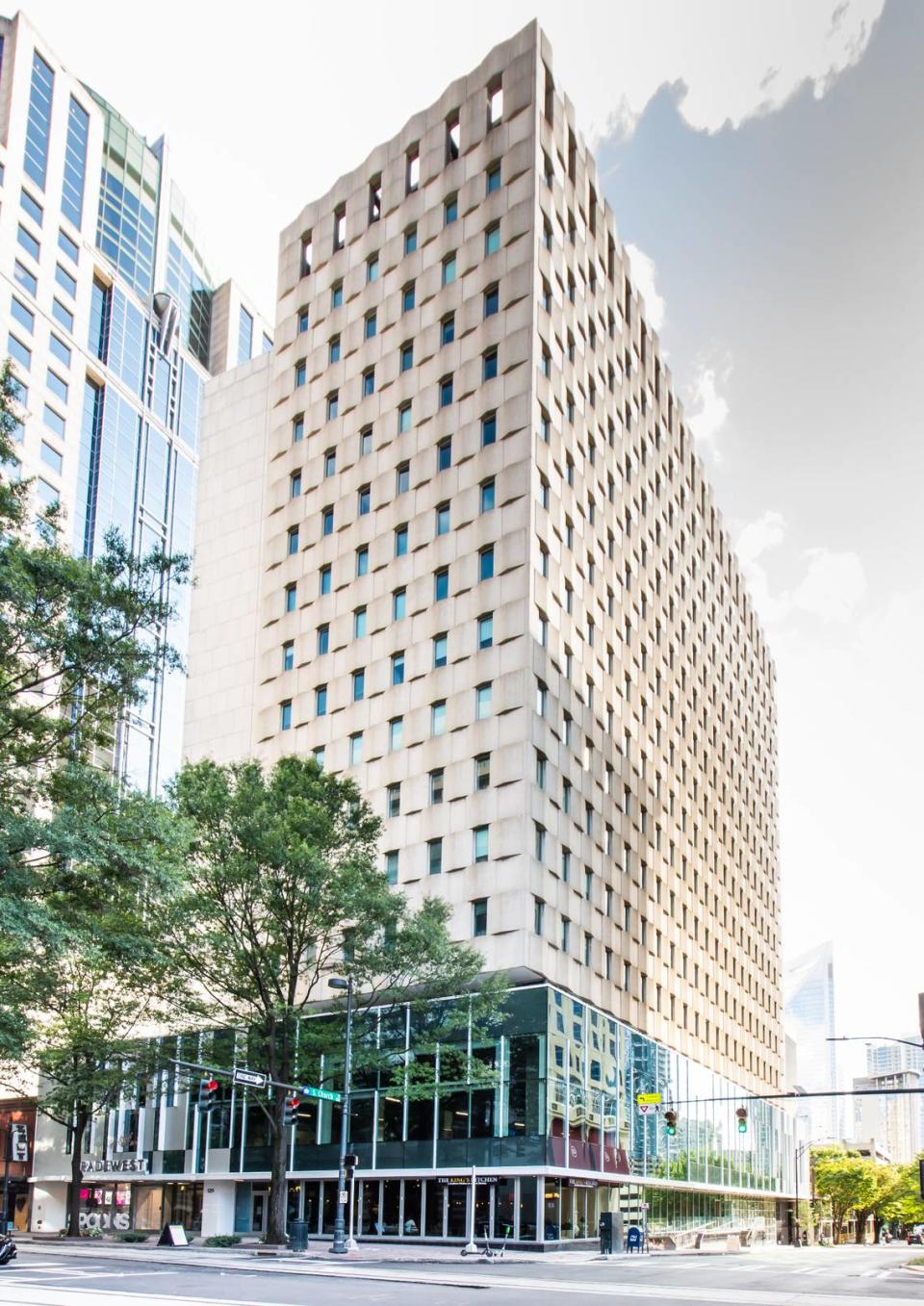
Troubled office mortgage loans
But what will happen to buildings with owners who can’t sign new leases?
Vacancy rates spell trouble for office building owners in many ways — no more so than the ability to pay off mortgage loans.
One type of loan exemplifies this issue: commercial mortgage-backed securities.
Essentially, investors buy a pool of packaged bonds which are then held in a trust. That serves as collateral for a mortgage-backed security, according to the CMBS Loans website.
The problem is, when tenants start to vacate space, the owner isn’t generating as much income. There are other ways investors can keep an eye on the performance of these loans. A large tenant vacating a building can be among the reasons that trigger a building to land on a CMBS watchlist. Updates to the watchlist are filed monthly by loan servicers, according to a recent story by the Triangle Business Journal.
Across Charlotte, 13 office buildings sit on this watchlist, according to data from CoStar Group.
Eight of those were built prior to 1990. They range from mid-rise suburban campus offices like Carmel Crossings in south Charlotte to Two Wells Fargo, a 32-story tower in uptown that recently has been listed for sale.
Three of the properties — the Cambridge Corporate Center in the University area, Fresenius Medical Care off North Hoskins Road and Whitehall Corporate Center V near the airport — have been on the list since the fall of 2020, according to CoStar and Trepp, a New York-based real estate data and analytics firm.
Big increases in vacancies were cited as the triggers for the placement of a handful of the buildings on the watchlist, according to a Trepp analysis provided to The Charlotte Observer.
Properties are typically put on the watchlist if they’re owners are having trouble with late debt payments or if there’s a reason they could have issues paying off future payments, according to the Triangle Business Journal.
In December 2022, Internet sales and marketing giant Red Ventures vacated nearly 98,000 square feet of office space at the Cambridge Corporate Center, according to the Trepp analysis. Red Ventures paid a lease termination fee of roughly $3 million as it had a lease expiration the following summer, Trepp data show.
The space is being marketed and brokers have been giving tours at other office suites, according to Trepp.
Packard Place is another building on the watchlist. A former automobile showroom built in 1928, the building has been converted into office space. Occupancy has been steadily declining, from 86% in 2020 to about 55% last year, according to Trepp.
Northpond Partners, a real estate investment firm out of Illinois, purchased the building in July 2021 for $15.4 million. The company declined to comment on the watchlist status.
But Northpond recently announced it’s investing $4 million into the property, a spokeswoman said. Northpond is updating the exterior and the first floor common area with all-day food and drink options.
Doubts, hopes about the Charlotte office market
Loan troubles are not unique to Charlotte.
There are nine buildings on the CMBS watchlist in the Raleigh and Durham area, CoStar data show. In bigger cities like Los Angeles, nearly all office tower owners owe more to the bank than the buildings are currently worth, according to a recent story by Slate.
In May, the percentage of CMBS loans that are seriously delinquent is 3.4%, according to Trepp. Among the reasons a loan is marked that way is if it’s been delinquent for 60 days or more, according to Trepp.
Banks holding the loans typically don’t like the uncertainty in the office market surrounding return-to-work shifts, Moody’s Analytics Kevin Fagan recently told NPR’s Marketplace. He predicted more building owners will miss payments in the months ahead.
The uncertainty is leaving some office tenants to sit on the sidelines, Vitner told the Observer. They feel they could get a better deal as more space becomes available. The same goes for prospective buyers who feel like prices are going to get better by waiting.
“People have doubts as to what the return to office is going to look like,” Vitner said.
Even with the record office vacancy around 22%, Vitner and others expressed confidence the city will recover.
Vitner recalls that as the country climbed out of the 2008 financial crisis, there were signs around uptown that things were coming back to life. Busier lunch crowds was one of them.
He’s seeing that today as he walks around uptown. Longer lines at restaurants and people out at night.
Citing a famous Yogi Berra quote, Vitner said: “You can observe a lot just by watching.”
